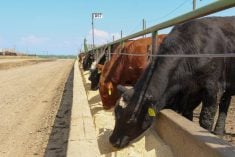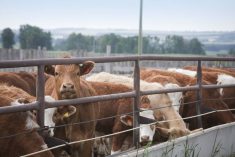During the first week of February Alberta packers were buying fed cattle in the range of $157 to $159 delivered, which was down from early-January highs of $165 to $168. U.S. first-quarter beef production is coming in larger than expected. The U.S. weekly slaughter has been six to seven per cent above year-ago levels.
In addition to the higher weekly slaughter, the average dressed weight is running about 10 pounds above last year. U.S. feedlot conditions are considered poor due to adverse weather, which has resulted in poor feedlot performance. We may see carcass weights decline over the next few weeks.
Read Also

Harvest wraps up and fall work begins
At the Eppich famly ranch in western Saskatchewan, the fall harvest was successful with few breakdowns, cows and calves have been sorted and a new tractor has arrived
In Alberta, the average dressed weights are running below 2019 while the slaughter pace has been running similar to last year. Alberta feedlot margins have been hovering around breakeven. Western Canadian yearling prices have been on the defensive because pen space is limited. Alberta and Saskatchewan feedlot inventories are up 20 per cent from the five-year average. Prices for lighter calves and grass cattle remain firm. Yearling supplies during the fall of 2020 are expected to be down four to five per cent from 2019. At this stage, 2021 first-quarter beef production is expected to have a sharp year-over-year decrease. As of late February, medium-frame mixed steers on a light grain diet weighing about 840 pounds were quoted at $185 in central Alberta; mixed steers weighing 550 pounds were valued at $225 in the same region.
Cattle on feed as of Jan. 1 were 11.958 million head, up two per cent from 11.690 million head last year. Placements during Dec. 2019 were 1.828 million head, up 61,000 head or three per cent from 1.767 million head during Dec. 2018. Fed cattle marketings during Dec. 2019 were 1.834 million head, up five per cent from 1.741 million head during Dec. 2018. U.S. feedlot placements from September through December 2019 were 8.476 million head, up from 8.036 million head for the same four-month period during 2018. First-quarter beef production is now expected to finish near 6.5 billion pounds, however, second-quarter beef production could reach over 7.1 billion pounds. Second-quarter beef production is expected to be up 326 million pounds from 2019.
My Jan. 2020 column stated that market-ready supplies in Alberta and Saskatchewan during June and July could be up 100,000 head over last year. We’ve seen a sharp increase in feeder cattle imports during the final quarter of 2019, which will result in burdensome fed cattle supplies during the summer of 2020.
While the fed cattle market has an extremely bearish outlook, the feeder market looks more optimistic longer term. The USDA estimated the 2019 calf crop at 36.060 million head, down 254,000 head or one per cent from the 2018 calf crop. In addition to the lower calf crop, I mentioned earlier that feeder cattle were placed sooner than normal this past fall. Feeder cattle outside of U.S. feedlots as of Jan. 1 are expected to be down about three per cent compared to Jan. 1, 2019. The yearling market is expected to slowly trend lower into the summer. Feedlot margins will deteriorate into the summer. Alberta fed cattle prices are expected to drop by $15 between February and July. Barley prices are expected to percolate higher into the spring. This represents a double hit against the yearling market in the short term.
The year-over-year decrease in the U.S. calf crop will result in a tight yearling supply situation during August and September. I’m expecting 850-pound steers to trade above $200 next fall. Cattle that will be placed on grass during the summer have been very strong and will likely trade at higher levels throughout the spring and summer. Keep in mind I’m expecting barley prices to drop below $200/mt in southern Alberta during the 2020 harvest. Weaker feed grain prices will contribute to the stronger yearling market.
The coronavirus situation is considered a “black swan” variable for the cattle and beef markets. As of mid-February, it was not considered a pandemic because all 360 deaths have been in China with the exception of one. It’s important to realize the World Health Organization estimates that on any given year between 250,000 and 500,000 people die annually from the flu. In any case, the restricted travel of Chinese tourists within and outside of China has potential to result in lower beef demand. It’s very difficult to project the effects on the cattle and beef market long term. In 2009, the H1N1 influenza virus reached a pandemic level, but this is now a regular flu virus.
















